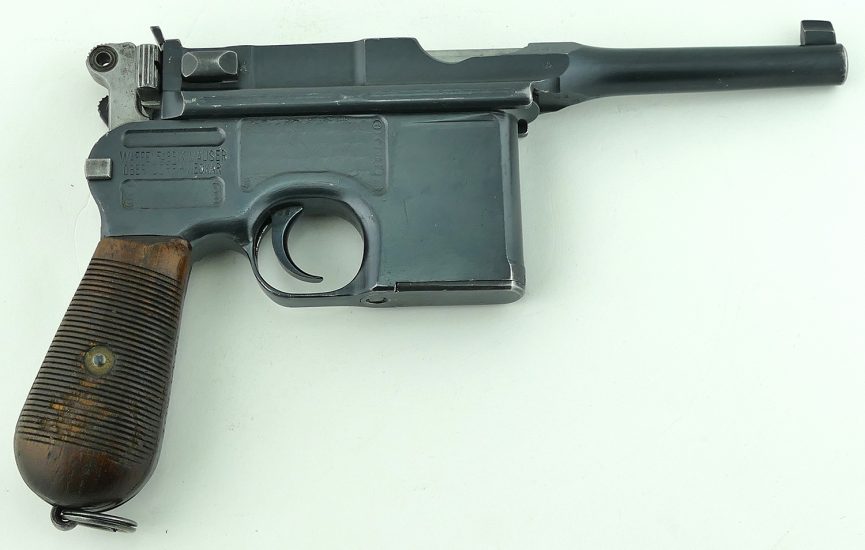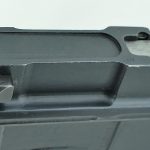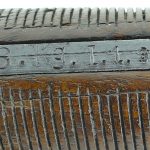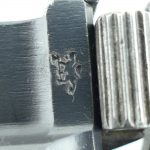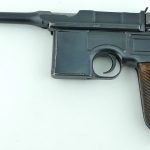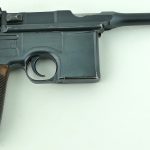Identifying Obscure Markings on Mauser C/96 Broomhandle Pistols, Part 2
In a previous post, we examined a Red 9 1920 rework C/96. In this post, we will examine and attempt to decipher the markings on another Red 9 rework, albeit with a much more convoluted trail.
 This pistol started life as part of the 150,000 gun contract of 9mm C/96’s known as “Red Nines” in WWI. It has the standard Mauser chamber and left side markings, and is standard in all basic respects.
This pistol started life as part of the 150,000 gun contract of 9mm C/96’s known as “Red Nines” in WWI. It has the standard Mauser chamber and left side markings, and is standard in all basic respects.
In the immediate post WWI era, as part of the Treaty of Versailles, many military C/96 pistols had their barrels cut to 4″ to comply with the terms of the Treaty. This gun had its barrel cut, the rear tangent sight removed and replaced with a brazed-on notch sight, and at some point the Red 9 grips were replaced with a set of unmarked standard wood grips.
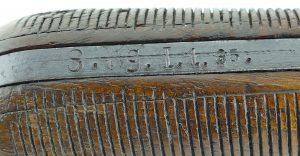 The gun was then issued to a Weimar Police unit, being marked S. Kg. I. 1. 95, which translates to Schutzpolizei (municipal police), Koenigsberg, first centuria, first command, gun number 95. When collecting, it’s always important to remember that many German WWI era guns will be found with Weimar police markings, and are often misidentified as WWI unit markings. For the C/96 if it’s unit marked, it’s a very safe bet to assume it’s a Weimar era police mark.
The gun was then issued to a Weimar Police unit, being marked S. Kg. I. 1. 95, which translates to Schutzpolizei (municipal police), Koenigsberg, first centuria, first command, gun number 95. When collecting, it’s always important to remember that many German WWI era guns will be found with Weimar police markings, and are often misidentified as WWI unit markings. For the C/96 if it’s unit marked, it’s a very safe bet to assume it’s a Weimar era police mark.
 Following its Schutzpolizei service, the police markings were cancelled, and this C/96 went to Simson for refurbishment. The extractor and safety were salt blued, and the magazine floor plate was refinished in a salt blue as well. An eagle SU4 symbol was applied to the right barrel flat at this time, indicating this work was done by Simson.
Following its Schutzpolizei service, the police markings were cancelled, and this C/96 went to Simson for refurbishment. The extractor and safety were salt blued, and the magazine floor plate was refinished in a salt blue as well. An eagle SU4 symbol was applied to the right barrel flat at this time, indicating this work was done by Simson.
 Here the gun’s history usually goes cold, as Nazi era C/96 use is sketchy at best. This gun, however, has a Norwegian rampant lion stamped on the left rear of the barrel extension. That symbol means that the gun was sold out of Norwegian military service, and was legally sold on the civilian market. This of course begs the question of why the Norwegian military was buying surplus C/96 Mausers from the Germans in the early 1930’s? Or perhaps the gun was issued to a German Soldier stationed in Norway during WWII, and then captured by the Norwegian military and taken into service? Either way, we can say that the Norwegian rampant lion was probably put on the gun in the immediate post WWII period, when the Norwegian Armed Forces were reorganizing their weapons, and eliminating obsolete surplus arms.
Here the gun’s history usually goes cold, as Nazi era C/96 use is sketchy at best. This gun, however, has a Norwegian rampant lion stamped on the left rear of the barrel extension. That symbol means that the gun was sold out of Norwegian military service, and was legally sold on the civilian market. This of course begs the question of why the Norwegian military was buying surplus C/96 Mausers from the Germans in the early 1930’s? Or perhaps the gun was issued to a German Soldier stationed in Norway during WWII, and then captured by the Norwegian military and taken into service? Either way, we can say that the Norwegian rampant lion was probably put on the gun in the immediate post WWII period, when the Norwegian Armed Forces were reorganizing their weapons, and eliminating obsolete surplus arms.
As this gun vividly illustrates, knowing the history of a gun brings a new layer of richness to collecting. From the trenches of WWI through the chaos of Weimar Germany to pitched battles with resistance fighters in Norway, this C/96 has been witness to some of the most tumultuous years of the 20th Century, and has the marks to prove it!
More Images:
Do you have an item like this one that you are interested in selling?
We purchase collectible firearms and military antiques every day at Pony Express Firearms – please contact us today if you would like to sell your item!

